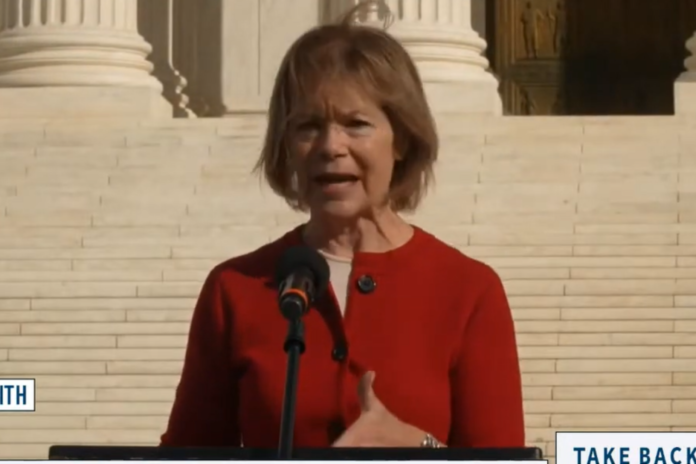
Two congresswomen from Minnesota, Sen. Tina Smith and Rep. Ilhan Omar, participated in a hybrid rally to support an expansion of the Supreme Court this week.
The event, hosted by Take Back the Court Action Fund and People’s Parity Project, took place Tuesday afternoon and featured a variety of speakers, including Democratic lawmakers and leftist activists. The activists joined in via Zoom, while the lawmakers spoke outside the Supreme Court Building.
Speaking after Sen. Ed Markey of Massachusetts, Smith promoted a baseless conspiracy theory that Republicans “stole” the court after legally appointing two justices via a constitutionally established democratic process during the Trump administration.
She claimed the “two stolen seats” were decades in the making and involved strategic collusion between corporate interests, the Republican Party, right-wing activists, and the Federalist Society.
“We are at a moment where we must fight to protect our democracy,” she added. “Decisions being made by this Republican-captured Supreme Court are taking away our rights every day. Whether it is about allowing unlimited spending in our elections, whether it is about gutting the Voting Rights Act, whether it is allowing partisan gerrymandering, or whether it is allowing the kind of travesty that we are seeing right now in Texas.”
In late September, Smith became the first cosponsor of Sen. Markey’s bill to expand the Supreme Court to 13 justices. The move came just one year after she repeatedly dodged questions about court packing.
“[Packing the court] is not what I’m looking at,” Smith said during an October 2020 debate with Republican challenger Jason Lewis.
Rep. Omar gave her remarks on the Supreme Court near the end of the event. She claimed a whole host of radical Democratic agenda items and even “democracy itself” are under siege from “Donald Trump and all of his Republican cronies.”
Omar also noted how Congress has the ability to change the number of Supreme Court seats and has done so multiple times. But the last time Congress did so was 1869. The last serious attempt at expanding the Supreme Court took place in 1937, when President Franklin D. Roosevelt drafted legislation that would’ve added a new justice each time a sitting justice failed to retire at age 70.
However, congressional Democrats — members of Roosevelt’s own party — refused to make his proposed legislation law, claiming it was unconstitutional and unnecessarily divisive.
Increasing numbers of contemporary Democrats may not wish to learn from the lessons of history and the mistakes of their party, but the idea of Supreme Court expansion remains just as divisive and risky, if not more so, than it was in the 1930s. A commission established by President Joe Biden to dispassionately weigh the pros and cons of SCOTUS expansion has warned of the idea’s “considerable drawbacks.”
“The risks of court expansion are considerable, including that it could undermine the very goal of some of its proponents of restoring the court’s legitimacy,” the report reads. “If the country and the political system were to be embroiled in repeated fights over court expansion, that alone could harm the Supreme Court’s public reputation.”
















